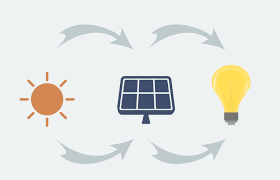Sunshine and smiles ☀️ That’s how we all like to start our day. Isn’t it?
Well, let us try to understand what is solar energy and how the sunshine lights up our homes.
Solar energy, derived from the sun, holds the key to a cleaner, greener future. This renewable energy source acts as a bright solution to mitigate the issue of climate change and the situation of escalating power tariffs across states in India.
Read on to find out more about solar energy and its benefits to households and the environment.
Understanding how solar energy works
Solar energy works on a simple principle.
- It begins with the sun, which emits radiant energy in the form of sunlight and then converts to electricity through a process called the photovoltaic effect. When sunlight, which consists of photons, hits the solar panels, equipped with photovoltaic cells, it excites the electrons within the cell’s material. These cells contain semiconductor materials that convert sunlight into direct current (DC) electricity through the photovoltaic effect.
- The structure of the solar cell ensures that this flow of electrons is in a specific direction, creating a direct current (DC) of electricity. An inverter then converts this DC electricity into alternating current (AC) electricity, which can be used to power households, businesses, and industries.

What are the different types of solar energy?
Solar energy can be found in 4 primary forms:
- Solar Photovoltaic (PV) Systems: These systems convert sunlight into electricity directly using solar panels.
- Solar Thermal Systems: These systems harness the power of sunlight to heat water or air for residential, commercial, and industrial purposes.
- Concentrated Solar Power (CSP) Systems: CSP systems use mirrors or lenses to concentrate sunlight onto a small area, generating heat that drives steam turbines to produce electricity.
- Passive Solar Heating and Cooling: This approach utilizes building design and materials to capture and store solar energy for heating and cooling purposes without the use of mechanical systems.
Solar energy and its applications
In residential households, solar panels provide clean electricity for powering homes, thereby reducing electricity bills.
Across commercial and industrial sectors, solar energy is utilized for powering offices, factories, and warehouses, offering cost savings and environmental benefits.
Solar energy is used to power remote areas, providing electricity where traditional infrastructure is lacking.
In agriculture, solar energy powers irrigation systems, water pumps, and farm equipment, enhancing productivity.
Solar energy also fuels transportation through solar-powered vehicles and charging stations, reducing carbon emissions.
Furthermore, solar energy is harnessed for heating purposes across homes, swimming pools, and industrial processes, offering an efficient and eco-friendly alternative to conventional heating methods.
A renewable resource for a sustainable future
Renewable sources of energy include wind, hydroelectric, biomass, and geothermal energy. Wind energy harnesses the power of the wind to generate electricity, while hydroelectric energy utilizes flowing water to produce power. Biomass energy relies on organic materials such as wood and agricultural residues. Geothermal energy taps into the Earth’s heat.
Of all these renewable resources, solar energy holds particular significance due to its versatility, scalability, and accessibility. With the sun shining for billions of years, solar energy is considered to be inexhaustible, By harnessing this abundant and sustainable resource, we can reduce our reliance on non-renewable energy sources and transition towards a better sustainable future.
How can households benefit from solar energy?
- Usage: Solar energy can be used for various purposes like electricity, supply water, etc.
- Significant Cost Savings: By generating their own electricity, households can reduce or even eliminate their dependence on power generated by respective electricity departments, resulting in substantial long-term savings.
- Environmental Impact: Solar energy produces clean and renewable power, thereby reducing greenhouse gas emissions and its impact on climate change.
- Energy Independence: Solar energy provides households with great control over their energy production and consumption, fostering energy independence.
The role of solar panels in power generation
The heart of solar energy production lies in the solar panel. A solar panel consists of numerous photovoltaic cells. These cells convert sunlight into electricity. When sunlight falls on these cells, it excites electrons within the semiconductor material, generating an electric current. This direct current is then converted into alternating current through an inverter, making it suitable for powering household appliances and electronics.
These panels can be easily installed on rooftops or in open spaces with ample sunlight. Installation typically involves mounting the panels on a sturdy structure and connecting them to an inverter, which converts the generated DC electricity into AC electricity. Solar panels have become increasingly accessible, offering homeowners a clean and renewable energy solution to power their homes.
In terms of maintenance, they are easy to maintain. The solar panels need to be cleaned just twice every year.
How much electricity does one solar panel produce?
An efficient 1kW solar panel system can produce about 4-5 units of electricity, which is around 120 units of electricity per month. The daily electricity production produced by solar panels can vary based on weather conditions.
To find out more about solar panels and how you can generate electricity from them, click here.

Why solar energy has a great future in India and the Government’s role
A recent study by Ember Energy highlighted India’s remarkable contribution to global solar energy generation. The report, which analyzes electricity data from the first half of 2023, reveals that India contributed 12% to the global increase in solar generation during the said period.
This powered half of India’s electricity demand over the same period, demonstrating the immense potential of solar energy in meeting India’s energy needs.
India’s efforts to continuously rely on renewable resources like solar energy and wind energy have reduced the growth of coal-generated power.
The Union Government of India recognizes the importance of solar energy adoption and has introduced several initiatives to incentivize rooftop solar installation amongst Indian households especially the economically weaker sections.
Under the Pradhan Mantri Suryoday Yojana scheme, the rooftop solar subsidy has been increased to 60%, making solar energy more accessible and affordable for homeowners. The subsidy for the northeast and hilly states across India will be 70%.
The installation cost of one kilowatt (KW) of solar rooftop systems is approximately ₹50,000, with each KW capable of generating around 120 units of electricity per month.
Is solar energy available everywhere?
Solar energy in general can be harnessed in any place on Earth. However, the availability and intensity of solar radiation depend on the time of the day and the location. So what if we need to generate power in uneven and difficult terrains like hilly or mountain regions or places that receive continuous rainfall?
Well, there is now an innovative way to generate electricity through both solar and wind energy.
Introducing Suryavya: A hybrid energy solution
Suryavya (a combination of Surya and Vayu in Sanskrit) is a hybrid renewable energy device that produces electricity through both wind and solar energy. This product harnesses both solar and wind power to generate electricity efficiently.

Combining the powers of solar and wind energy
During daylight, Suryavya draws power from the solar panels, harnessing the sun’s abundant energy. As the sun sets, Suryavya seamlessly transitions to wind power. This dual-source approach ensures a constant and reliable power supply, enabling households to generate power from both mediums.
How does it work?
The hybrid device produces direct current through a generator and an electric converter changes DC to AC with steady voltage and this current is stored in a battery. As and when the power is required, the current stored can be used. The device can operate initially on 500 Watts of solar energy and 1 KW of wind energy and can be scaled up to the user’s requirement. The device can be set up easily and only requires minimal maintenance. You just need to apply distilled water to the battery and clean the solar panels regularly.
Investment and savings
Investing in solar is a long-term game that results in savings and monetary benefits. By drawing power even through wind, Suryavya doubles the energy production and capacity and thereby reduces your monthly electricity bill initially. Based on a few conditions, it can even reduce the electricity bill by up to 0! To know more on how you can reduce your monthly electricity bill and double your savings, click here.
Conclusion: A brighter future with solar energy and Suryavya
In conclusion, solar energy represents a positive shift towards a more sustainable and environmentally friendly energy future. By harnessing the power of the sun, households can not only reduce their monthly electricity bills but also contribute to a clean and green environment.
The Govt is also accelerating the pace of rooftop solar installations and increasing the subsidies for individual house owners to go ahead and implement solar energy.
With an innovative solution like Suryavya, the transition to renewable energy has never been more easy and attainable.
Experience the power of solar and wind energy with Suryavya
Take the first step towards a sustainable future by scheduling a demo of Suryavya today.
Together, let us create a brighter tomorrow for generations to come.
